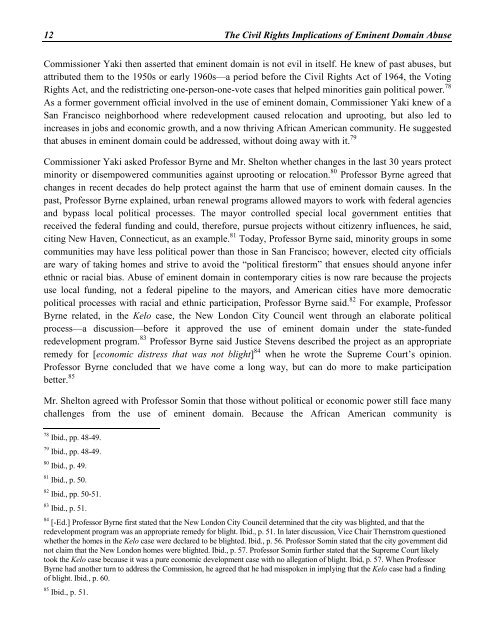You also want an ePaper? Increase the reach of your titles
YUMPU automatically turns print PDFs into web optimized ePapers that Google loves.
12 The Civil Rights Implications of <strong>Eminent</strong> <strong>Domain</strong> AbuseCommissioner Yaki then asserted that eminent domain is not evil in itself. He knew of past abuses, butattributed them to the 1950s or early 1960s—a period before the Civil Rights Act of 1964, the VotingRights Act, and the redistricting one-person-one-vote cases that helped minorities gain political power. 78As a former government official involved in the use of eminent domain, Commissioner Yaki knew of aSan Francisco neighborhood where redevelopment caused relocation and uprooting, but also led toincreases in jobs and economic growth, and a now thriving African American community. He suggestedthat abuses in eminent domain could be addressed, without doing away with it. 79Commissioner Yaki asked Professor Byrne and Mr. Shelton whether changes in the last 30 years protectminority or disempowered communities against uprooting or relocation. 80 Professor Byrne agreed thatchanges in recent decades do help protect against the harm that use of eminent domain causes. In thepast, Professor Byrne explained, urban renewal programs allowed mayors to work with federal agenciesand bypass local political processes. The mayor controlled special local government entities thatreceived the federal funding and could, therefore, pursue projects without citizenry influences, he said,citing New Haven, Connecticut, as an example. 81 Today, Professor Byrne said, minority groups in somecommunities may have less political power than those in San Francisco; however, elected city officialsare wary of taking homes and strive to avoid the “political firestorm” that ensues should anyone inferethnic or racial bias. Abuse of eminent domain in contemporary cities is now rare because the projectsuse local funding, not a federal pipeline to the mayors, and American cities have more democraticpolitical processes with racial and ethnic participation, Professor Byrne said. 82 For example, ProfessorByrne related, in the Kelo case, the New London City Council went through an elaborate politicalprocess—a discussion—before it approved the use of eminent domain under the state-fundedredevelopment program. 83 Professor Byrne said Justice Stevens described the project as an appropriateremedy for [economic distress that was not blight] 84 when he wrote the Supreme Court’s opinion.Professor Byrne concluded that we have come a long way, but can do more to make participationbetter. 85Mr. Shelton agreed with Professor Somin that those without political or economic power still face manychallenges from the use of eminent domain. Because the African American community is78 Ibid., pp. 48-49.79 Ibid., pp. 48-49.80 Ibid., p. 49.81 Ibid., p. 50.82 Ibid., pp. 50-51.83 Ibid., p. 51.84 [-Ed.] Professor Byrne first stated that the New London City Council determined that the city was blighted, and that theredevelopment program was an appropriate remedy for blight. Ibid., p. 51. In later discussion, Vice Chair Thernstrom questionedwhether the homes in the Kelo case were declared to be blighted. Ibid., p. 56. Professor Somin stated that the city government didnot claim that the New London homes were blighted. Ibid., p. 57. Professor Somin further stated that the Supreme Court likelytook the Kelo case because it was a pure economic development case with no allegation of blight. Ibid, p. 57. When ProfessorByrne had another turn to address the Commission, he agreed that he had misspoken in implying that the Kelo case had a findingof blight. Ibid., p. 60.85 Ibid., p. 51.


